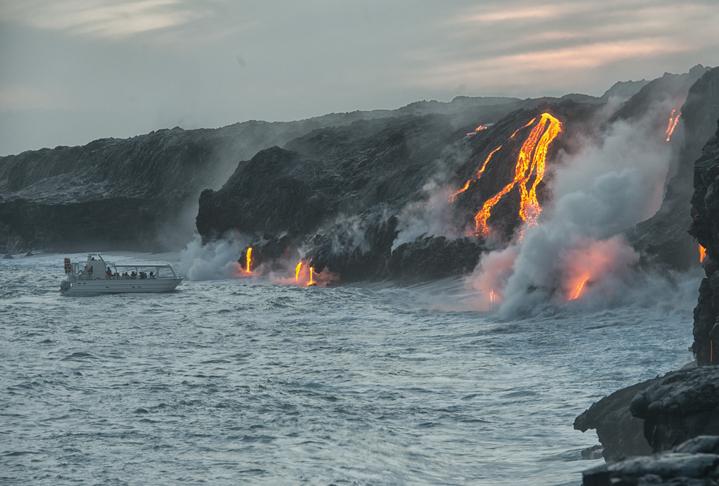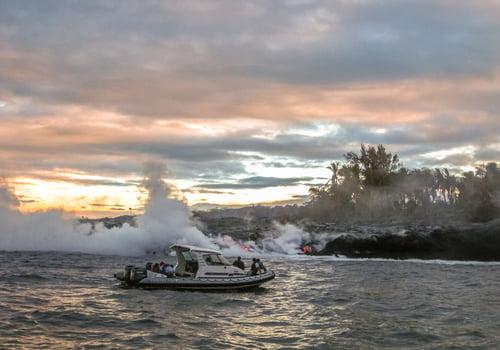Hawaii is home to six active volcanoes, but you’ll only find them on the islands of Maui and Hawaii (the Big Island). But don’t count on seeing any lava on Maui. It’s a massive volcano, Haleakala, which is a National Park. It also hasn’t erupted since the 1600s.
The Big Island is home to five still-active volcanoes, but two of them -- Hualalai and Loihi -- aren’t likely to show you any molten rock. Hualalai last erupted in 1801, and Loihi is completely underwater. That leaves Mauna Kea, Mauna Loa and Kilauea for lava watching.
Mauna Kea and Mauna Loa are the island’s two 13,000-foot peaks, and they erupt every six years, or so. But Kilauea has been continuously erupting since the 1980s. Sometimes its activity is low, and other times the volcano is actively and violently erupting. Unfortunately, there’s no way to forecast these eruptions for your viewing pleasure.
But you should be able to see molten rock, in one form or another, during your Big Island vacation. After all, The Big Island continues to grow by 40 acres per year because of this constant volcanic activity. And the most reliable way to see the flowing lava is by plane and boat. But, which should you choose?
Volcanoes National Park
 A massive eruption in May of 2018 changed the landscape inside Volcanoes National Park. For decades, Volcanoes National Park has been the most reliable place in Hawaii for lava viewing. The park even features the Jagger Museum which has a platform that allows visitors to peer into the Halema’uma’u Crater from a safe distance. And, up until the landscape-changing eruption of May 2018, the crater featured an ever-constant pool of lava.
A massive eruption in May of 2018 changed the landscape inside Volcanoes National Park. For decades, Volcanoes National Park has been the most reliable place in Hawaii for lava viewing. The park even features the Jagger Museum which has a platform that allows visitors to peer into the Halema’uma’u Crater from a safe distance. And, up until the landscape-changing eruption of May 2018, the crater featured an ever-constant pool of lava.
The pool was drained, and so has all the lava from inside Volcanoes National Park. But the park rangers aren’t worried. Similar eruptions and drainings have taken place in the past, and the lava has always come back to the park.
This significant change may influence your decision to fly or boat to the flowing lava during your Hawaii vacation. The crater and the ever-present flow of lava inside the park made it a dream for airplane operators. They simply swirled over the park to give you incredible views of the bubbling molten rock. Now, airplane operators have to search for Kilauea’s lava flows, and the lava flows are always changing directions.
Where Does The Lava Flow?
 If you landed in Kona, then you had an aerial view of a lava field. The city of Kona sits right in the middle of hardened, glassy, black rock. It’s the remnants of a lava flow that came down the slopes of the island’s massive mountains. The rock is so young that vegetation has yet to grow on the west side of the island.
If you landed in Kona, then you had an aerial view of a lava field. The city of Kona sits right in the middle of hardened, glassy, black rock. It’s the remnants of a lava flow that came down the slopes of the island’s massive mountains. The rock is so young that vegetation has yet to grow on the west side of the island.
But, unless something drastic changes, lava won’t be flowing on the west side of the island. These days, the lava is usually flowing in an area called the Lower East Rift Zone which is in the southeast of the island. That’s where you’ll find Kilauea and Mauna Kea’s lava vents. It’s also where you’ll find Volcanoes National Park.
The eruption zones and lava flows change on this side of the island, but the flow usually pours into the Pacific in this area. And it’s the lava flowing into the ocean which is most reliable for viewing.
How Does The Lava Flow
 You’ll be shocked to find houses built into the newly formed volcanic rock in the Lower East Rift Zone. Some of these communities have been devastated when the lava flows in the area decided to change direction to burn right through the buildings. That’s just how unpredictable the lava flows can be.
You’ll be shocked to find houses built into the newly formed volcanic rock in the Lower East Rift Zone. Some of these communities have been devastated when the lava flows in the area decided to change direction to burn right through the buildings. That’s just how unpredictable the lava flows can be.
And the lava doesn’t always flow on the top of the ground like a river. Sometimes, the lava flows underground in newly formed lava tubes. But the molten rock almost always drains into the Pacific Ocean. This is how The Big Island continues to grow by about 40 acres per year.
Eruption Zones
 The exact spot where lava is coming out of the ground can change, as well. After all, the May 2018 eruption drained the Halema’uma’u Crater which had been reliable for lava for decades.
The exact spot where lava is coming out of the ground can change, as well. After all, the May 2018 eruption drained the Halema’uma’u Crater which had been reliable for lava for decades.
The eruptions all happen in a similar area, but pinpointing the eruption zone can be difficult, especially if the lava is flowing low. And you can’t always count on a huge caldron of lava during your Hawaiian vacation. It may just be a trickle of molten rock that may not be visible from the above. It could be flowing completely underground.
A Plane Is More Impressive, If…
 You might want to take a plane to the eruption zone if there is a lot of volcanic activity. There’s nothing like seeing molten rock rage in a bubbling cauldron, and it’s especially beautiful when the sun is setting and the lava is glowing. The plane can also give you the grandeur of the entire scene. You’ll be able to see the eruption zone as well as the powerful river of molten rock that is pouring from it.
You might want to take a plane to the eruption zone if there is a lot of volcanic activity. There’s nothing like seeing molten rock rage in a bubbling cauldron, and it’s especially beautiful when the sun is setting and the lava is glowing. The plane can also give you the grandeur of the entire scene. You’ll be able to see the eruption zone as well as the powerful river of molten rock that is pouring from it.
But you may be left underwhelmed if there is not a lot of volcanic activity during your visit to the Big Island. The eruption zone may be small, elusive and much of the flowing lava may be hiding underground in lava tubes. Essentially, you’ll fly over the beautiful island of Hawaii looking for lava. The flight itself is bound to be enjoyable, but you may strike out on the lava itself.
A Boat Is More Dependable
 The lava is almost always pouring into the Pacific Ocean on the southeastern side of the island. It pours into the ocean if the lava is flowing underground or above ground. And it pours into the ocean even if the eruption zones have moved and Volcanoes National Park has drained.
The lava is almost always pouring into the Pacific Ocean on the southeastern side of the island. It pours into the ocean if the lava is flowing underground or above ground. And it pours into the ocean even if the eruption zones have moved and Volcanoes National Park has drained.
This is how the new island is born. The lava flows of the island shelf to harden. The molten rock continues to build upon itself until the island grows. And the newly formed island will look a lot like the west side of the Big Island for years to come. The glassy, black rock of newly formed islands will eventually be covered in dirt, and then vegetation will move in. Centuries from now, that newly formed island will be covered in greenery and white sand beaches will form.
And it is this newly formed island that provides a glimpse into the mortality of the islands themselves. The volcanoes that created Niihau, Kauai, Oahu, Molokai, Lanai, and Kaho’olawe are all now dead. That means every gust of wind, a drop of rain and footstep are wearing the islands down. Eventually, they’ll sink into the Pacific like so many Hawaiian islands before them, and new volcanoes will give birth to new islands in their places.
You can see this cycle of Hawaiian island life up close and personal on a lava-viewing tour boat. The boat will take you as close to the lava as you can safely get, and you can watch as the lava creates a massive plume of steam and glass. This plume is deadly, but you’ll be safe under the supervision of professionals.
Conclusion: Plane or Boat?
 An airplane will give you dramatic and sweeping views of the entire volcanic scene. You’ll be able to peer into the eruption zone, see the bubbling magma and then you’ll be able to follow the lava as it pours into the ocean. But you may be underwhelmed if there is little or no volcanic activity during your visit.
An airplane will give you dramatic and sweeping views of the entire volcanic scene. You’ll be able to peer into the eruption zone, see the bubbling magma and then you’ll be able to follow the lava as it pours into the ocean. But you may be underwhelmed if there is little or no volcanic activity during your visit.
A boat will only take you to one location -- the pour point where the lava drops into the Pacific -- but it’s the most reliable way to see lava during your Hawaiian vacation. You’ll be able to see just how the new island is formed, and you can ruminate about the impermanence of the islands themselves.
You can get online to see if there is a volcanic activity during your visit. Make sure to read news stories carefully to see if conditions are ripe for an airplane visit to the lava. If the volcanic activity is low, then you should book a seat on a boat as quickly as possible.
Unfortunately, volcanic activity is nearly impossible to forecast. You won’t be able to plan this one out ahead of time. It may cause you some anxiety, but, if you really want the lava experience of a lifetime, you may want to wait until the last minute to book either a plane or a boat depending on the conditions.